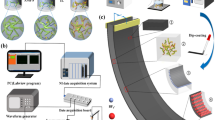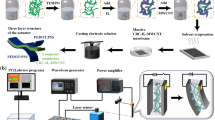Abstract
High-performance electroactive ionic artificial muscles have received widespread attention in braille displays, haptic devices, active biomedical devices, and soft robots. Herein, we report a novel low voltage ecofriendly ionic polymer actuator based on bacterial cellulose (BC), polyvinyl alcohol (PVA), and ionic liquid (IL). The designed BC-IL-PVA actuator exhibited superior actuation performances, such as low driving voltage (< 1.5 V), long bending durability (97% retention for 4 h), and large bending strain (0.29% at sinusoidal waveform of 1.0 V with 0.1 Hz), and wide driving frequency (up to 5 Hz), which were ascribed to the strong crosslinking and ionic interactions of BC nanofibers with PVA and IL. Furthermore, a bionic finger based on the designed actuator was successfully demonstrated for playing music and sliding electronic photos on smart photo screens. Therefore, the proposed BC-IL-PVA ionic actuator will offer a feasible approach for developing high-performance soft actuators, artificial muscles, active medical devices, and soft robots.





Similar content being viewed by others
Data availability
Data will be made available on reasonable request.
References
M. Acerce, E.K. Akdoğan, M. Chhowalla, Metallic molybdenum disulfide nanosheet-based electrochemical actuators. Nature 549, 370–373 (2017)
K. Xiang, T. Chen, Y. Wang, The highly stable air-working electro-active ionic polymer actuator based on nitrogen-doped graphene aerogel flexible electrode. J. Mater. Sci.: Mater. Electron. 32, 21395–21405 (2021)
F. Wang, D. Huang, Q. Li, Y. Wu, B. Yan, Z. Wu, Highly electro-responsive ionic soft actuator based on graphene nanoplatelets-mediated functional carboxylated cellulose nanofibers. Compos. Sci. Technol. 231, 109485 (2023)
S. Huang, Y. Liu, Y. Zhao, Z. Ren, C.F. Guo, Flexible electronics: stretchable electrodes and their future. Adv. Funct. Mater. 29, 1805924 (2019)
F. Yu, J. Ciou, S. Chen, W. Poh, J. Chen, J.T. Chen, K. Haruethai, J. Lv, D. Gao, P. Lee, Ionic covalent organic framework based electrolyte for fast-response ultra-low voltage electrochemical actuators. Nat. Commun. 13, 1–8 (2022)
M. Sadeghi, Y. Hojjat, M. Khodaei, Design, analysis, and optimization of a magnetoelectric actuator using regression modeling, numerical simulation and metaheuristics algorithm. J. Mater. Sci.: Mater. Electron. 30, 16527–16538 (2019)
C. Jo, D. Pugal, I.K. Oh, K.J. Kim, K. Asaka, Recent advances in ionic polymer–metal composite actuators and their modeling and applications. Prog. Polym. Sci. 38, 1037–1066 (2013)
F. Wang, Y. Kong, F. Shen, Y. Wang, D. Wang, Q. Li, High-performance microfibrillated cellulose-based low voltage electroactive ionic artificial muscles in bioinspired applications. Composites B 228, 109436 (2022)
U. Raza, S. Oh, R. Tabassian, M. Mahato, I.K. Oh, Micro-structured porous electrolytes for highly responsive ionic soft actuators. Sens. Actuator B 352, 131006 (2022)
M.A. Mohd Asri, N.A. Ramli, A.N. Nordin, Electrical performance and reliability assessment of silver inkjet printed circuits on flexible substrates. J. Mater. Sci.: Mater. Electron. 32, 16024–16037 (2021)
S. Mishra, R. Sahoo, L. Unnikrishnan, A. Ramadoss, S. Mohanty, S.K. Nayak, Enhanced structural and dielectric behaviour of PVDF-PLA binary polymeric blend system. Mater. Today Commun. 26, 101958 (2021)
F. Wang, Q. Li, J.O. Park, S. Zheng, E. Choi, Ultralow voltage high-performance bioartificial muscles based on ionically crosslinked polypyrrole‐coated functional carboxylated bacterial cellulose for soft robots. Adv. Funct. Mater. 31, 2007749 (2021)
S. Mehraeen, S. Sadeghi, F. Cebeci, M. Papila, S.A. Gürsel, Polyvinylidene fluoride grafted poly (styrene sulfonic acid) as ionic polymer-metal composite actuator. Sens. Actuators A 279, 157–167 (2018)
S.Y. Jung, S.Y. Ko, J.O. Park, S. Park, Enhanced ionic polymer metal composite actuator with porous nafion membrane using zinc oxide particulate leaching method. Smart Mater. Struct. 24, 037007 (2015)
D. Zhao, Y. Zhu, W. Cheng, W. Chen, Y. Wu, H. Yu, Cellulose-based flexible functional materials for emerging intelligent electronics. Adv. Mater. 33, 2000619 (2021)
O.M. Vanderfleet, E.D. Cranston, Production routes to tailor the performance of cellulose nanocrystals. Nat. Rev. Mater. 6, 124–144 (2021)
K. Liu, H. Du, T. Zheng, H. Liu, M. Zhang, R. Zhang et al., Recent advances in cellulose and its derivatives for oilfield applications. Carbohydr. Polym. 259, 117740 (2021)
F. Rol, M.N. Belgacem, A. Gandini, J. Bras, Recent advances in surface-modified cellulose nanofibrils. Prog. Polym. Sci. 88, 241–264 (2019)
F. Wahid, L.-H. Huang, X.-Q. Zhao, W.-C. Li, Y.-Y. Wang, S.-R. Jia et al., Bacterial cellulose and its potential for biomedical applications. Biotechnol. Adv. 53, 107856 (2021)
J. Caro-Astorga, K.T. Walker, N. Herrera, K.-Y. Lee, T. Ellis, Bacterial cellulose spheroids as building blocks for 3D and patterned living materials and for regeneration. Nat. Commun. 12, 1–9 (2021)
A. Fatima, S. Yasir, M. Ul-Islam, T. Kamal, M. Ahmad, Y. Abbas et al., Ex situ development and characterization of green antibacterial bacterial cellulose-based composites for potential biomedical applications. Adv. Compos. Hybrid Mater. 5, 307–321 (2022)
Y. Huang, C. Zhu, J. Yang, Y. Nie, C. Chen, D. Sun, Recent advances in bacterial cellulose. Cellulose 21, 1–30 (2014)
X. Wu, H. Mou, H. Fan, J. Yin, Y. Liu, J. Liu, Improving the flexibility and durability of aged paper with bacterial cellulose. Mater. Today Commun. 32, 103827 (2022)
S.-P. Lin, I. Loira Calvar, J.M. Catchmark, J.-R. Liu, A. Demirci, Cheng, biosynthesis, production and applications of bacterial cellulose. Cellulose 20, 2191–2219 (2013)
J. Jayachandiran, S. Vajravijayan, N. Nandhagopal, K. Gunasekaran, D. Nedumaran, Fabrication and characterization of ZnO incorporated cellulose microfiber film: structural, morphological and functional investigations. J. Mater. Sci.: Mater. Electron. 30, 6037–6049 (2019)
Y. Wang, F. Wang, Y. Kong, L. Wang, Q. Li, Novel ionic bioartificial muscles based on ionically crosslinked multi-walled carbon nanotubes-mediated bacterial cellulose membranes and PEDOT: PSS electrodes. Smart Mater. Struct. 31, 025023 (2022)
J.-H. Jeon, I.-K. Oh, C.-D. Kee, S.-J. Kim, Bacterial cellulose actuator with electrically driven bending deformation in hydrated condition. Sens. Actuator B 146, 307–313 (2010)
S.-S. Kim, J.-H. Jeon, C.-D. Kee, I.-K. Oh, Electro-active hybrid actuators based on freeze-dried bacterial cellulose and PEDOT: PSS. Smart Mater. Struct. 22, 085026 (2013)
F. Wang, J.-H. Jeon, S. Park, C.-D. Kee, S.-J. Kim, I.-K. Oh, A soft biomolecule actuator based on a highly functionalized bacterial cellulose nano-fiber network with carboxylic acid groups. Soft Matter. 12, 246–254 (2016)
X. Luo, L. Zhu, Y. Wang, J. Li, J. Nie, Z.L. Wang, A flexible multifunctional triboelectric nanogenerator based on MXene/PVA hydrogel. Adv. Funct. Mater. 31, 2104928 (2021)
S. Suganthi, S. Mohanapriya, V. Raj, S. Kanaga, R. Dhandapani, S. Vignesh et al., Tunable physicochemical and bactericidal activity of multicarboxylic-acids‐crosslinked polyvinyl alcohol membrane for food packaging applications. ChemistrySelect 3, 11167–11176 (2018)
Q. Zhong, G. Shi, Q. Sun, J. Li, Robust PVA-GO-TiO2 composite membrane for efficient separation oil-in-water emulsions with stable high flux. J. Membr. Sci. 640, 119836 (2021)
E. Uslu, M. Gavgali, M.O. Erdal, S. Yazman, L. Gemi, Determination of mechanical properties of polymer matrix composites reinforced with electrospinning N66, PAN, PVA and PVC nanofibers: a comparative study. Mater. Today Commun. 26, 101939 (2021)
C. Ding, Z. Qiao, A review of the application of polyvinyl alcohol membranes for fuel cells. Ionics 28, 1–13 (2022)
N. Algethami, Structural, optical, electrical, and DFT studies of chitosan/polyvinyl alcohol composite doped with mixed nanoparticles (GO/TiO2) for flexible energy-storage devices. J. Mater. Sci.: Mater. Electron. 33, 25518–25531 (2022)
S. Chai, G. Zan, K. Dong, T. Wu, Q. Wu, Approaching superfoldable thickness-limit carbon nanofiber membranes transformed from water-soluble PVA. Nano Lett. 21, 8831–8838 (2021)
F. Bachtiger, T.R. Congdon, C. Stubbs, M.I. Gibson, G.C. Sosso, The atomistic details of the ice recrystallisation inhibition activity of PVA. Nat. Commun. 12, 1–14 (2021)
K. Qiu, A.N. Netravali, Bacterial cellulose-based membrane-like biodegradable composites using cross-linked and noncross-linked polyvinyl alcohol. J. Mater. Sci. 47, 6066–6075 (2012)
N. Terasawa, K. Asaka, Electrochemical and electromechanical properties of activated multi-walled carbon nanotube polymer actuator that surpass the performance of a single-walled carbon nanotube polymer actuator. Mater. Today 3, S178–S183 (2016)
F. Wang, Z. Jin, S. Zheng, H. Li, S. Cho, H.J. Kim, S. Kim, E. Choi, J. Park, S. Park, High-fidelity bioelectronic muscular actuator based on porous carboxylate bacterial cellulose membrane. Sens. Actuator B 250, 402–411 (2017)
L. Yang, Z. Sun, F. Li, S. Du, W. Song, Performance enhancement of cellulose-based biocomposite ionic actuator by doping with MWCNT. Appl. Phys. A 125, 1–15 (2019)
Z. Sun, L. Yang, D. Zhang, W. Song, High performance, flexible and renewable nano-biocomposite artificial muscle based on mesoporous cellulose/ionic liquid electrolyte membrane. Sens. Actuator B 283, 579–589 (2019)
M. Nan, D. Bang, S. Zheng, G. Go, B.A. Darmawan, S. Kim, H. Li, C. Kim, A. Hong, F. Wang, J. Park, E. Choi, High-performance biocompatible nanobiocomposite artificial muscles based on ammonia-functionalized graphene nanoplatelets–cellulose acetate combined with PVDF. Sens. Actuator B 323, 128709 (2020)
Acknowledgements
This work was supported by National Natural Science Foundation of China (51905487) and Zhejiang Provincial Natural Science Foundation of China (LY21E050023, LTY21F030001).
Author information
Authors and Affiliations
Contributions
FW: designing experiments, writing-original draft. DH: data curation. YW: analyzing data. DW: writing-review & editing.
Corresponding authors
Ethics declarations
Conflict of interest
The authors declare no conflict of interest.
Additional information
Publisher’s Note
Springer Nature remains neutral with regard to jurisdictional claims in published maps and institutional affiliations.
Electronic supplementary material
Below is the link to the electronic supplementary material.
Electronic supplementary material 2 (MP4 900 kb)
Electronic supplementary material 3 (MP4 2414 kb)
Electronic supplementary material 4 (MP4 2926 kb)
Rights and permissions
Springer Nature or its licensor (e.g. a society or other partner) holds exclusive rights to this article under a publishing agreement with the author(s) or other rightsholder(s); author self-archiving of the accepted manuscript version of this article is solely governed by the terms of such publishing agreement and applicable law.
About this article
Cite this article
Wang, F., Huang, D., Wu, Y. et al. Ecofriendly low voltage high-performance ionic artificial muscles based on bacterial cellulose nanofibers reinforced with polyvinyl alcohol. J Mater Sci: Mater Electron 34, 123 (2023). https://doi.org/10.1007/s10854-022-09648-x
Received:
Accepted:
Published:
DOI: https://doi.org/10.1007/s10854-022-09648-x




